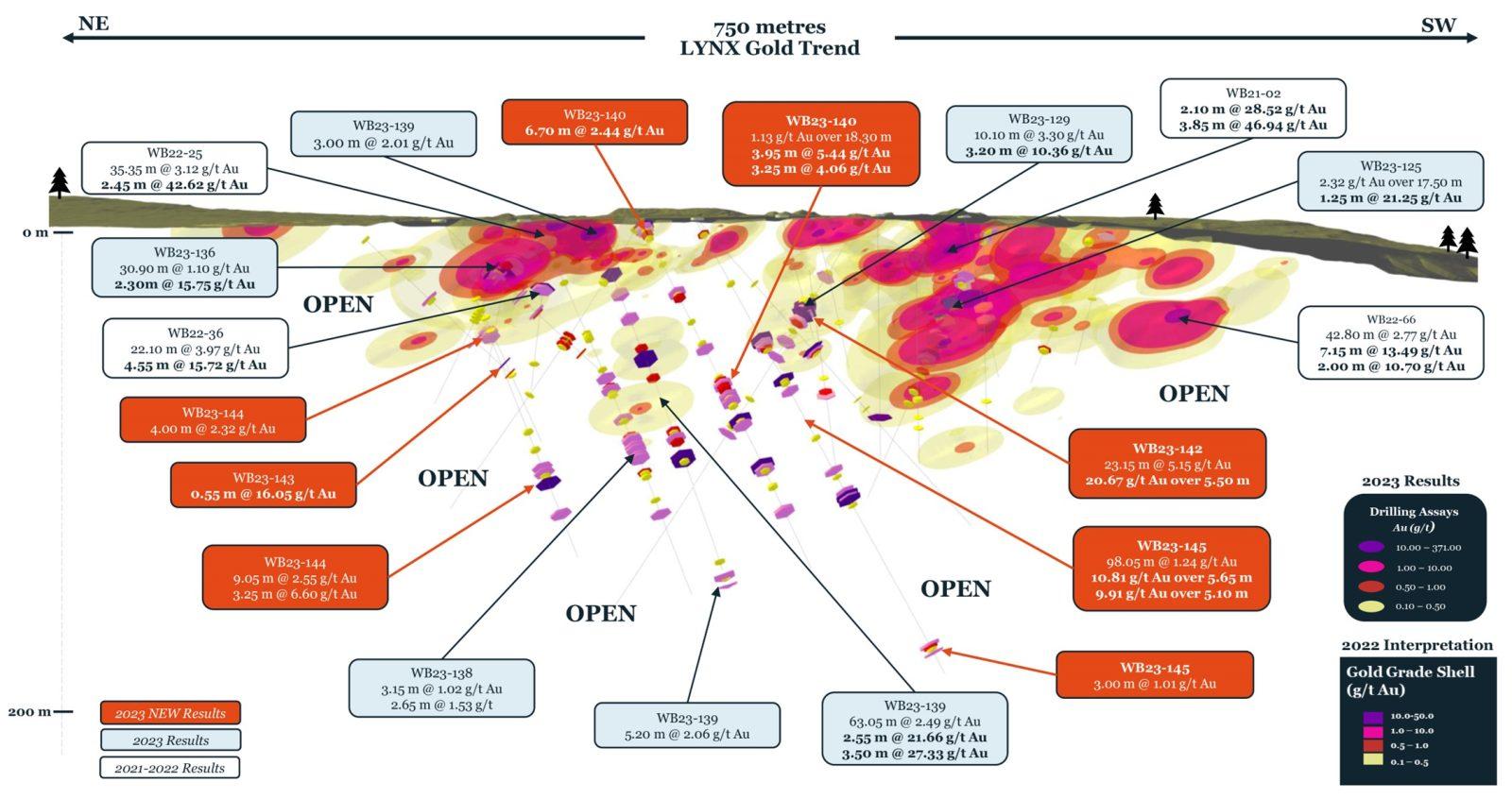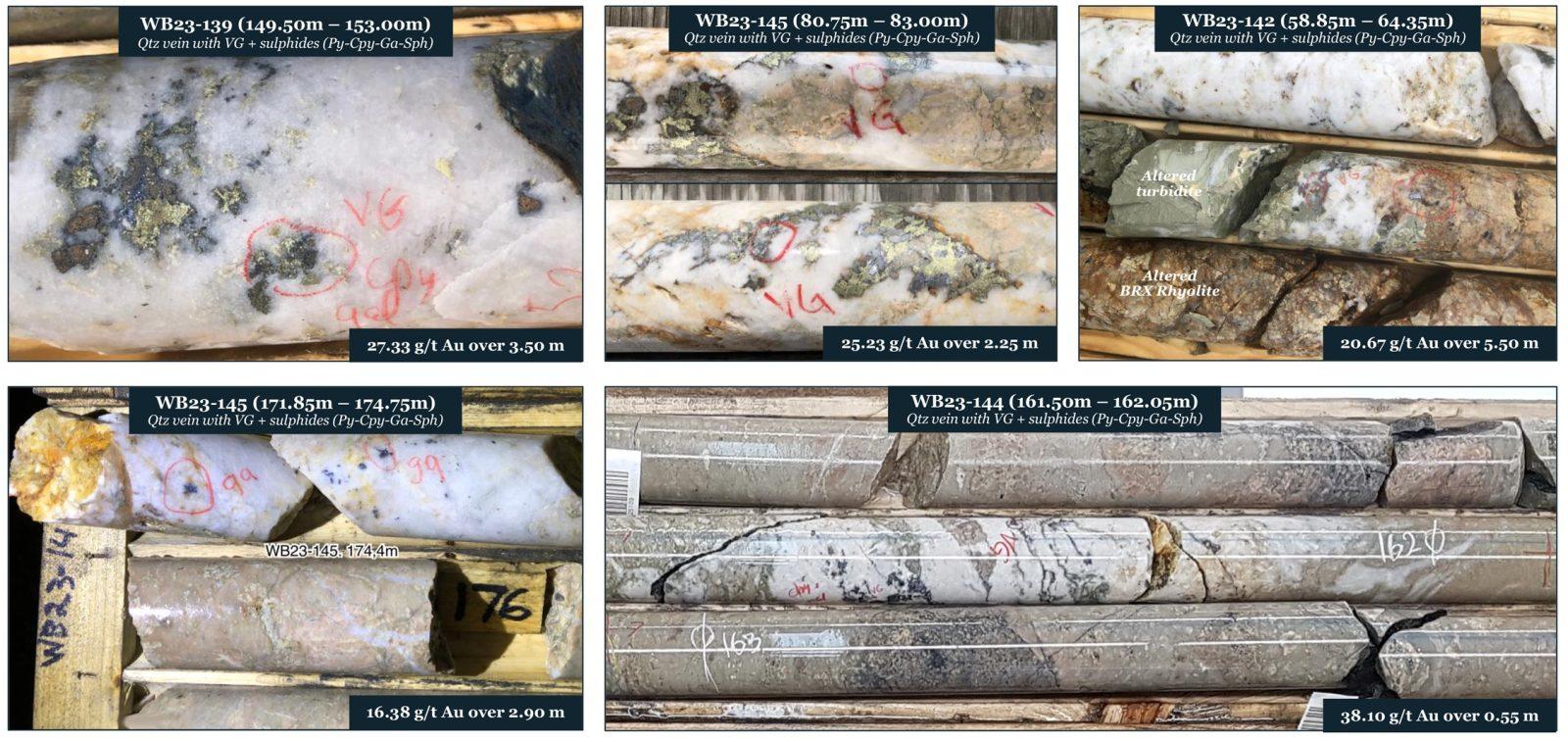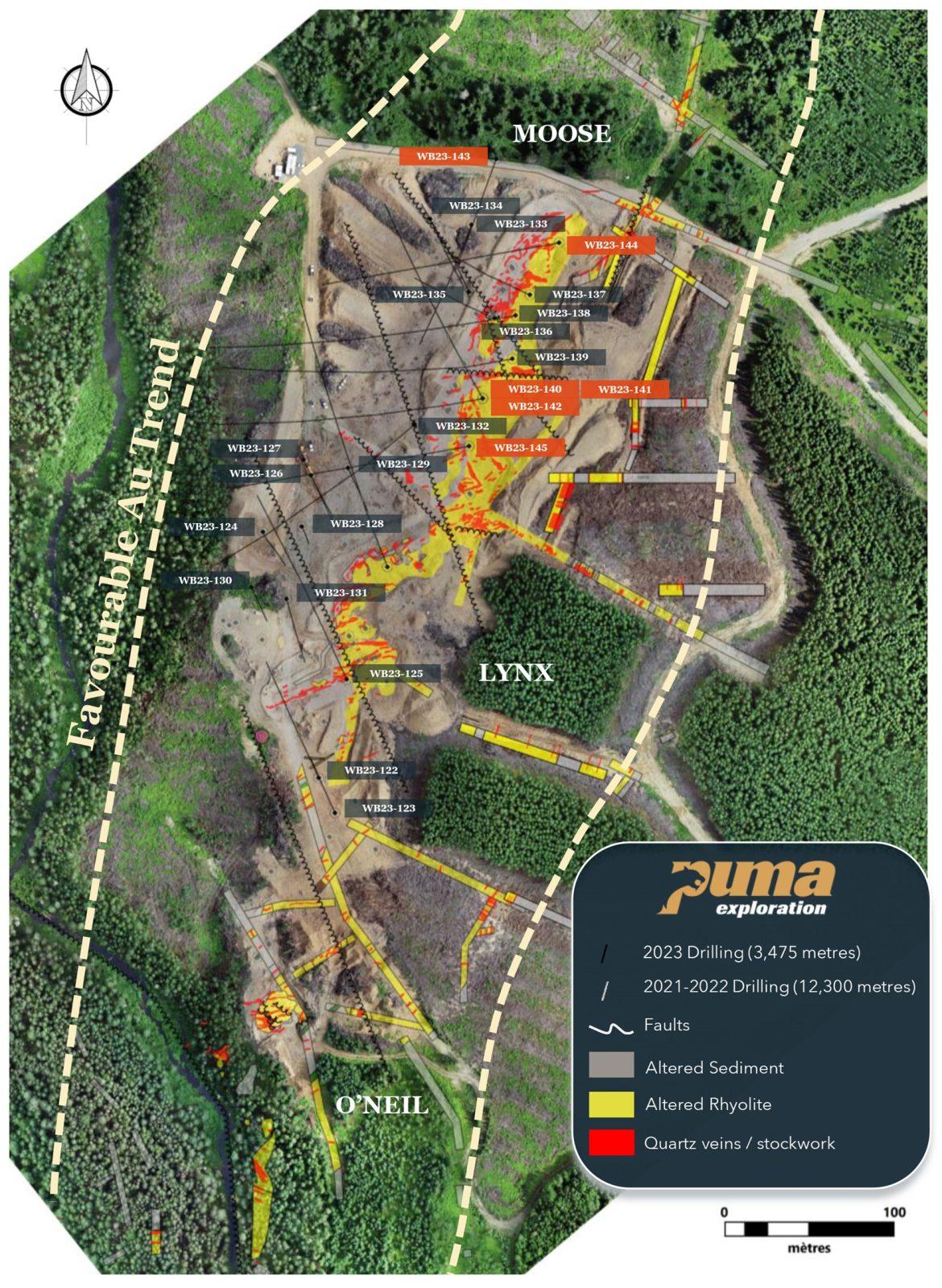
Puma Intersects 20.67 g/t Gold over 5.50 m within 32.15 m of 3.80 g/t Gold at the Lynx Gold Zone
- New high-grade gold veins were intercepted with 20.67 g/t gold over 5.50 m, within 32.15 m of 3.80 g/t gold in WB23-142, and 10.81 g/t gold over 5.65 m and 9.91 g/t gold over 5.10 m within 98.05 m of 1.24 g/t gold in WB23-145.
- Holes WB23-140, -142, -144 and -145 demonstrate the continuity of gold mineralization at Lynx, with mineralized envelopes extending over impressive lengths grading respectively 0.92 g/t gold over 43.70 m, 1.25 g/t gold over 100.90 m, 0.95 g/t gold over 25.60 m and 1.24 g/t gold over 98.05 m.
- Hole WB23-140 returned 4.06 g/t gold over 3.25 m from 155 m, WB23-144 returned 6.60 g/t gold over 3.25 m from 158 m, and WB23-145 returned 1.01 g/t gold over 3.00 m from 246 m expanding the known mineralization at depth and opening another area of gold mineralization.
Puma Exploration Inc. (TSX-V: PUMA) (OTCQB: PUMXF) is pleased to announce the results of the last six holes of its 2023 first phase drilling program at its 100%-owned Williams Brook Gold Project. All holes reported today successfully intersected the targeted favourable contact and a series of quartz veins and stockwork with gold mineralization. Drilling also extended the width and length of the high-grade gold shoots identified previously at Lynx and demonstrated the continuity of mineralization over long intervals (Figures 1 and 2).
Additional high-grade gold shoots were intercepted underneath the high-grade gold veins sampled at surface, confirming our model of multiple stacked veins extending at depth. The gold shoots have now been confirmed to extend downhole to at least 250 m and over a strike length of at least 400 m. Of particular interest, a group of high-grade gold veins assayed 20.67 g/t gold over 5.50 m within a large section of 32.15 m grading 3.80 g/t gold in WB23-142, and also in WB23-145 where a section of 5.65 m returned 10.81 g/t gold and another graded 9.91 g/t gold over 5.10 m, within a broad intersection of 98.05 m at 1.24 g/t gold.
The gold mineralization at Lynx extends both laterally and at depth over impressive lengths, such as 100.90 m of 1.25 g/t gold in WB23-142 and 98.05 m of 1.24 g/t gold in WB23-145. These long intervals emphasize the continuity of the mineralization and indicate that gold is present outside the core of the high-grade gold shoots. This is good news for potential open pit mining scenarios and will positively impact the mineral resource estimation of the deposit.
Figure 1. Cross-section of Lynx gold area with today’s reported results
Hole WB23-140 intersected 6.70 m of 2.44 g/t gold starting at surface, followed by several high-grade intervals such as 3.95 m of 5.44 g/t gold and 3.25 m of 4.06 g/t gold at depth. Hole WB23-144 returned 6.60 g/t gold over 3.25 m from 158 m, and WB23-145 returned 1.01 g/t gold over 3.00 m from 246 m. Gold mineralization was still present at 249 m downhole depth, indicating that the system remains open. Today’s results expand the already wide distribution of the high-grade gold shoots, with mineralized intervals beginning at or near surface.
Puma’s President and CEO Marcel Robillard commented, “This latest set of results adds considerable scale and volume to the Lynx Gold Zone, which remains open along strike and at depth. Drilling shows impressive continuity downhole and between drill holes. We see similar geology, alteration, structural characteristics, geochemistry, and stacking of high-grade gold veins in all drill holes. Our recent fieldwork shows that some of the same attributes characterize the Tiger Gold Zone, located 350 m away. The potential for a sizeable kilometre-wide and deep system, similar to Fosterville, is possible here, and we’ll continue to expand the zone with our ongoing exploration program.”
”The first phase of our 2023 drilling campaign was a huge success, with many intersections showing metal factors exceeding 10 and up to 165, proving the robustness of the gold system. The drill rig is now being mobilized, and our technical team is excited to test new targets at Lynx, at depth and along strike with the second phase of our 2023 drilling program.” added Réjean Gosselin, Puma’s Executive Chairman.
Figure 2. Pictures of Bonanza gold-grade core samples
Lynx Gold Zone Depositional Model
Samples of drill core with very high-grade gold veins were sent to an external consultant for petrographic (thin section) analysis to help characterize the gold system at the LGZ. The samples were also sent for additional XRF whole-rock geochemical analysis. Most of the holes drilled show pervasive sericitization with pyrite, tetrahedrite, sphalerite, galena, minor chalcopyrite, and malachite. Visible gold and associated potential bonanza-grade veins appear to be linked to the presence of carbonate alteration with elevated silver, bismuth, and base metals values (Cu-Pb-Zn).
A detailed mapping study in collaboration with Terrane Geoscience’s structural experts also indicates that the gold mineralization at the LGZ is associated with and controlled by extensional veins and breccias arranged in a ladder pattern.
The favourable contact at the LGZ appears to have acted as a major plumbing zone between sediment (turbidite) and felsic volcanic (rhyolite), with gold veins developing within the turbidite itself in contrast to the surrounding rock.
Dr. Gregg Morrison, a leading expert on intrusion-related, porphyry and epithermal gold systems, has reviewed the geology and classified rock and core samples of the Lynx Gold Zone for their texture, mineralogy, and multi-element geochemistry. He stated: “I believe Williams Brook is part of the same family of gold systems as Fosterville and Sunday Creek in Australia and Valentine Lake in Newfoundland. These other deposits are known for their structure-controlled mineralization, metal zoning, free gold in bonanza shoots and kilometre scale depth extent. The similarities to these more comprehensively explored deposits gives real confidence to deeper drilling in the Lynx Zone and continued exploration around the feeder structures in the Williams Brook District’’.
Figure 3: Location of 2023 drill holes
Table 1. Assay results for holes WB23-140 to 145
| DDH # | From (m) | To (m) | Length (m) | Au (g/t) |
| WB23-140 | 3.30 | 159.15 | 155.85 | 0.42 |
| incl, | 3.30 | 10.00 | 6.70 | 2.44 |
| incl, | 4.00 | 7.00 | 3.00 | 5.21 |
| and | 49.25 | 53.40 | 4.15 | 0.44 |
| and | 85.90 | 86.50 | 0.60 | 1.76 |
| and | 115.00 | 158.70 | 43.70 | 0.92 |
| incl, | 115.00 | 133.30 | 18.30 | 1.43 |
| incl, | 129.35 | 133.30 | 3.95 | 5.44 |
| incl, | 129.35 | 130.25 | 0.90 | 21.50 |
| and | 155.45 | 158.70 | 3.25 | 4.06 |
| incl, | 155.45 | 156.45 | 1.00 | 10.75 |
| and | 180.00 | 181.40 | 1.40 | 1.20 |
| WB23-141 | 79.70 | 84.30 | 4.60 | 0.30 |
| WB23-142 | 36.10 | 137.00 | 100.90 | 1.25 |
| incl, | 58.85 | 91.00 | 32.15 | 3.80 |
| incl, | 58.85 | 82.00 | 23.15 | 5.15 |
| incl, | 58.85 | 69.30 | 10.45 | 11.21 |
| incl, | 58.85 | 64.35 | 5.50 | 20.67 |
| and | 67.50 | 69.30 | 1.80 | 1.86 |
| and | 80.25 | 82.00 | 1.75 | 0.93 |
| and | 90.70 | 91.00 | 0.30 | 9.61 |
| and | 136.45 | 137.00 | 0.55 | 1.24 |
| WB23-143 | INDIVIDUAL SAMPLE IN WB23-143 | |||
| 48.40 | 49.30 | 0.90 | 1.22 | |
| 77.00 | 77.85 | 0.85 | 2.44 | |
| 94.45 | 95.00 | 0.55 | 16.05 | |
| WB23-144 | 72.85 | 178.60 | 105.75 | 0.32 |
| incl, | 72.85 | 76.85 | 4.00 | 2.32 |
| and | 72.85 | 73.65 | 0.80 | 6.88 |
| and | 76.25 | 76.85 | 0.60 | 6.16 |
| and | 153.00 | 178.60 | 25.60 | 0.95 |
| incl, | 153.00 | 162.05 | 9.05 | 2.55 |
| incl, | 158.80 | 162.05 | 3.25 | 6.60 |
| incl, | 161.50 | 162.05 | 0.55 | 38.10 |
| and | 177.65 | 178.60 | 0.95 | 1.12 |
| WB23-145 | 79.85 | 251.00 | 171.15 | 0.74 |
| incl, | 79.85 | 177.90 | 98.05 | 1.24 |
| incl, | 80.35 | 109.25 | 28.90 | 2.26 |
| incl, | 79.85 | 88.85 | 9.00 | 6.87 |
| incl, | 80.35 | 86.00 | 5.65 | 10.81 |
| incl, | 80.75 | 83.00 | 2.25 | 25.23 |
| and | 105.30 | 107.80 | 2.50 | 1.41 |
| and | 158.45 | 178.60 | 20.15 | 2.73 |
| incl, | 169.65 | 174.75 | 5.10 | 9.91 |
| incl, | 171.85 | 174.75 | 2.90 | 16.38 |
| and | 246.00 | 249.00 | 3.00 | 1.01 |
All interval widths reported are along the core axis; true widths of the system are unknown.
Table 2. Coordinates of drill holes
| DDH # | Station | Easting (m)* | Northing (m)* | Elevation (m) | Azimuth (°) | Dip (°) | Length (m) |
| WB23-140 | L270E | 660343 | 5259458 | 387 | 260 | -45 | 218 |
| WB23-141 | L270E | 660343 | 5259458 | 387 | 330 | -45 | 178 |
| WB23-142 | L180E | 660287 | 5259359 | 388 | 338 | -46 | 236 |
| WB23-143 | L340E | 660351 | 5259599 | 386 | 202 | -45 | 101 |
| WB23-144 | L350E | 660388 | 5259550 | 386 | 260 | -46 | 197 |
| WB23-145 | L250E | 660335 | 5259430 | 388 | 260 | -46 | 275 |
| * Projection: UTM Nad83 zone 19 | Total: | 1,205 | |||||
About the Williams Brook Gold Project
Puma’s flagship Williams Brook Gold Project comprises four properties covering more than 60,000 ha in Northern New Brunswick—an established and mining-friendly jurisdiction near paved roads and with excellent infrastructure nearby. The land package is located near the Rocky Brook Millstream Fault (“RBMF”), a major regional structure formed during the Appalachian Orogeny and a significant control for gold deposition in the region.
Since 2021 and with less than C$12M of exploration investment. Puma has made multiple gold discoveries at the Williams Brook property and believes that the property hosts an extensive orogenic gold system. Puma’s ongoing exploration programs are focused on building a gold camp in Northern New Brunswick, Canada.
Figure 4. Main gold showings and occurrences at the Williams Brook Gold Project
Qualified Person
The technical information of this release was reviewed and approved by Dominique Gagne, P.Geo. a consultant of Puma and a qualified person as defined by the National Instrument 43-101 – Standards of Disclosure for Mineral Projects.
On-Site Quality Assurance/Quality Control Measures
Drill cores are bagged, sealed and sent to ALS CHEMEX in Moncton, New Brunswick, where each sample is crushed and pulped before being fire-assayed (Au-ICP21). The remaining coarse reject portions of the samples remain in storage for further work or verification as needed. As part of its QA/QC program, the Company inserts external gold standards (low to high grade) and blanks every 20 samples in addition to standards, blanks, and duplicates. All samples over 10 g/t gold or with abundant visible gold are analyzed with a gravity finish (Au-GRA22). Check assays are routinely performed for samples with visible gold to ascertain the gold content of the mineralization zone.
About Puma Exploration
Puma Exploration is a Canadian-based mineral exploration company with precious metals projects in New Brunswick, near Canada’s Famous Bathurst Mining Camp (“BMC”). Puma has a long history in Northern New Brunswick, having worked on regional projects for over 15 years. As a first mover, the Company quickly and strategically accumulated an impressive portfolio of prospective gold landholdings in the area. Puma’s successful exploration methodology combines old prospecting methods with detailed trenching and up-to-date technology such as Artificial Intelligence (“AI”) to facilitate an understanding of the geology and associated mineralized systems. Armed with geophysical surveys, geochemical data and consultants’ expertise, Puma has developed a perfect low-cost exploration tool to discover gold at shallow depths and maximize drilling results.
The Company is also committed to deploying its DEAR strategy (Development. Exploration. Acquisition. and Royalties) to generate maximum value for shareholders with low share dilution.
MORE or "UNCATEGORIZED"
Red Pine Discovers Significant Gold Mineralization in Faulted Extension of the Jubilee Shear on the Wawa Gold Project
Red Pine Exploration Inc. (TSX-V: RPX) (OTCQB: RDEXF) is pleased ... READ MORE
F3 Announces Closing of Private Placement for Aggregate Gross Proceeds of C$8 Million
F3 Uranium Corp. (TSX-V: FUU) (OTC Pink: FUUFF) is pleased to ann... READ MORE
Collective Mining Announces Closing of Concurrent Financings for Gross Proceeds of C$46.35 Million
Collective Mining Ltd. (NYSE: CNL) (TSX: CNL) is pleased to ann... READ MORE
ARIS MINING ANNOUNCES CLOSING OF US$450 MILLION SENIOR NOTES OFFERING TO FUND REDEMPTION OF OUTSTANDING 6.875% SENIOR NOTES
Aris Mining Corporation (TSX: ARIS) (NYSE-A: ARMN) announces t... READ MORE
Rare Element Resources Receives Final Approval Required to Commence Operations of Rare Earth Demonstration Plant in Wyoming
Staffing in place and operations shakedown underway Rare E... READ MORE

















